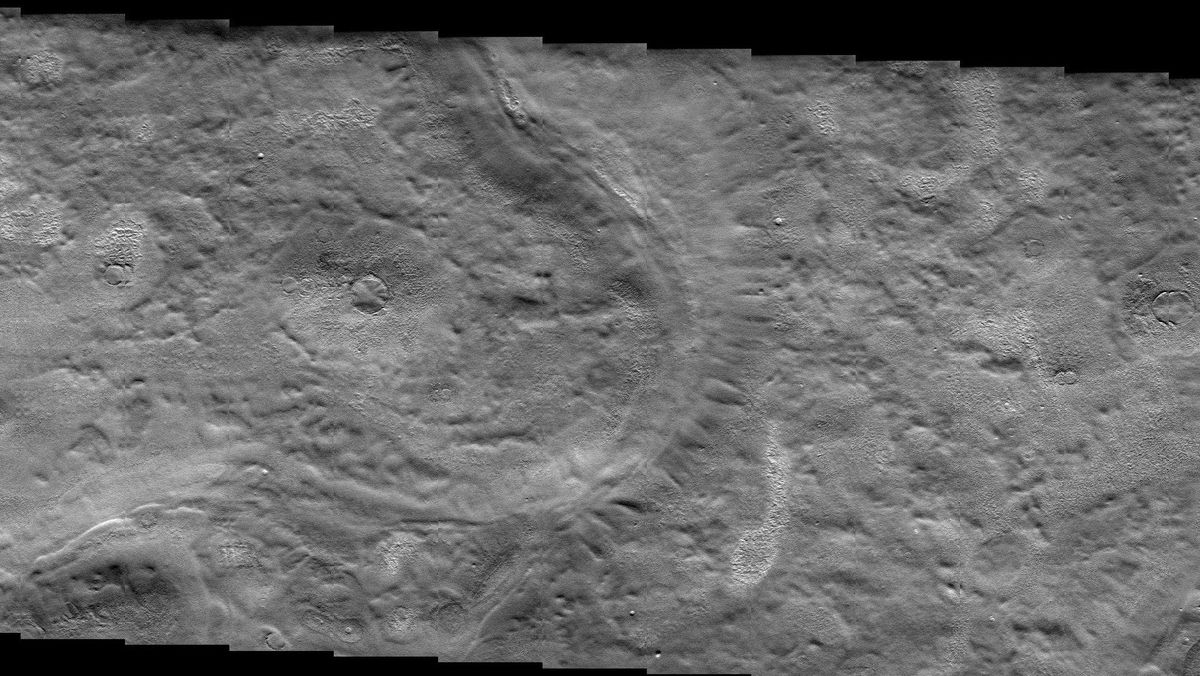
A potential Mars landing site might be underlain by debris-covered glaciers.
Strange sinuous features on a flat plain known as Arcadia Planitia bear a striking resemblance to ice streams within ice sheets in Antarctica, a new study finds. If these shallowly covered glaciers do, in fact, exist, they could be a reason to direct future crewed missions to Mars toward the region. The spot was already intriguing to SpaceX and NASA because it is a broad, flat plain, which is ideal for landing spacecraft. If there is ice not too deep below the surface of the plain, astronauts could also have a water source easily at hand.
The newfound flow-like features are strange because they occur on flat terrain, said study leader Shannon Hibbard, a doctoral student at the University of Western Ontario in Canada.
"There's lots of evidence that this is an ice-rich area, but we don't have any major topographic relief occurring where these sinuous features are," Hibbard told Live Science. "They're existing in a pretty flat-lying plane, so that was kind of odd."
Related: 5 Mars myths and misconceptions
Mystery landforms
Arcadia Planitia is in Mars' northern lowlands. In the last 3 billion years, active lava flows smoothed over this region, so that it is far less pocked with craters compared with other parts of the planet. Data collected from orbit over the years suggest that the ground in the region is rich in hydrogen. Because water is made of hydrogen and oxygen molecules, this hydrogen suggests the presence of water ice right below the surface.
For decades, scientists have noticed features on Mars that look ice-related. Alongside low hills, there are aprons of debris known as lobate features because of their shape, which look like the outflow of glaciers covered in a thin layer of rocks. There are also striated patterns within gullies that look similar to glaciers flowing through valleys on Earth.
Similar features occur in Arcadia Planitia, Hibbard said. Lobate features occur near a set of mountains known as the Erebus Montes that rise from the plain. Sinuous features snake through low-lying areas. She and her colleagues pulled together observations from multiple different instruments to try to identify these features. This included photographs from orbit, thermal data showing the temperature of the surface in both day and night, albedo data that reveals the reflectivity of the surface, information on the dust cover and data on elevation and topography.
Glacial flow
The sinuous features were the big mystery, Hibbard said, because they looked like they were made by ice flow, but the terrain wasn't steep enough to explain why the ice would be moving.
"We had to try to figure out what the heck are they, why do they have the thermal signatures that they have, why are they so bright in both day and night, why do they appear to have flow features, why are they channelized, why do they occur near lobate debris aprons?" she said.
Related: Photo tour of Jezero Crater: Here's where Perseverance landed on Mars
The analysis suggested that these features were, in fact, glacial in origin. The sinuous shapes looked similar to other features associated with slow-flowing material seen on Mars, Hibbard said, and the data suggested that these spots were indeed rich in ice.
What the sinuous features look most like, Hibbard said, is ice streams within ice sheets on Earth, which occur primarily in Antarctica. These faster-moving flows of ice aren't well understood on Earth, Hibbard said, much less Mars, but they do show an example of ice flowing in fairly flat terrain.
This is a controversial claim, Hibbard said, because most ice streams on Earth require at least a thin layer of liquid water at their base to lubricate their flow. It's not clear whether subglacial water exists or ever existed on Mars, she said, nor is it clear whether a wet base would be required to cause ice streams to flow on the Red Planet. One possibility is that in the past, when Mars' orbit was tilted differently than it is today and its climate was different, subglacial melt could have occurred.
"Ice streams are something that might be on Mars and might suggest more complex glacial processes have taken place on Mars, which I think is really interesting," Hibbard said.
The next step, she said, is to investigate the terrain surrounding these sinuous features for more clues. Arcadia Planitia has never been studied except from orbit, but it might be an exciting place to send future Mars missions, she added.
"It would be an interesting place to land not only for the accessibility of water ice and abundance of water ice, but also for the scientific value," Hibbard said.
The research appears in the May issue of the journal Icarus.
Originally published on Live Science.
https://ift.tt/2SrAsRv
Science
No comments:
Post a Comment